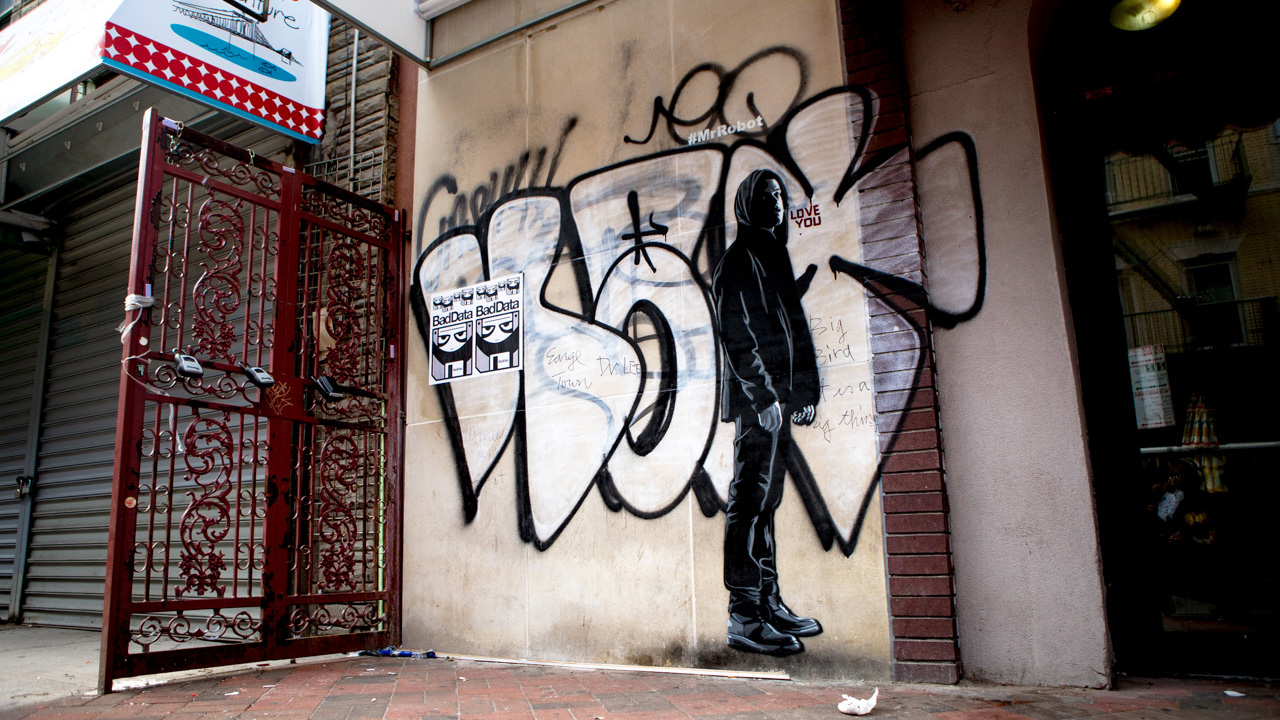To promote its new TV series Mr. Robot, USA Network rolled out a stealth marketing campaign that was crafted to look like real street art. The stenciled ads depict the show’s hoodie-wearing protagonist, a drug-using hacker played by Rami Malek, in various poses and were strategically painted around Manhattan next to or on top of legitimate murals, giving the visuals an air of authenticity.
Typically, it’s soulless advertising agencies that get paid tens of thousands of dollars to co-opt art to create highly deceptive programs meant to fool people, but this under-the-radar stunt was more of an inside job, dreamed up and proactively pitched to USA by known street artists Logan Hicks and Joe Iurato. The final design was identical to Iurato’s signature style and if not for the Mr. Robot hashtag, it would be impossible to differentiate between previous art that he’s done and these commercial executions.
To some of their peers, that’s not a good look. “When artists start blurring the lines between actual street art and an ad posing as street art, it’s deceiving,” said fellow street artist Gilf to ANIMAL. “It’s one thing if the ad agency does it themselves — it’s a completely different beast when you take a specific artist’s unique style and trick people into engaging with a brand because they recognize the artist’s style. This just feels like treason to me.” She also notes how there’s enough problematic street art being slapped up in the public space, no need to add the clutter.

In a Facebook post defending the ads, Hicks explained how he originally pitched USA on the project. After accepting the job, he brought on Iurato and asked the L.I.S.A. Project — a mural beautification group aiming to attract people to Little Italy — to help secure wall space. For the past few years, L.I.S.A has made some inroads by getting artists to paint gates all up and down Mulberry Street, and so when this fake street art started appearing next to real street art, it was off-putting. “To me, planting ‘street art’ ads next to public murals is worse than a Bushwick business taking $25,000 from a corporation to host a billboard,” said street photographer Daniel Albanese aka the Dusty Rebel. “At least a billboard is honest. It’s clearly marketing.” In one instance, the L.I.S.A. Project’s own Rey “The DRiF!” Rosa allowed the ad to be placed over his own artwork (pictured above), making it more of a collaboration and further muddying up the waters. And the campaign seems to be working. There’s are several Instagram users who seem to believe that Mr. Robot is a real person. “Love this street artwork by #MrRobot,” wrote Julius Poole.
In addition to these problems IRL, there appears to be a lack of transparency about the campaign on social media. Hicks and Iurato continually refer to the creative they did for the network as “artwork” and “street level branding,” but never mention the word “advertising,” which seems a bit disingenuous. Also at issue is how L.I.S.A. founder Wayne Rada first promoted the stencils on Instagram. In a post to the photo sharing platform, he highlighted one of the street art-looking ads as if it was a legitimate find that he just happened to stumble upon and not the initiative that he is being paid to be a part of. When reached by phone, Rada insists that he’s genuinely surprised by any backlash. “We thought it was a fun thing,” he said. Rada, who is the process of organizing a major street art festival, explained how the small organization needs the funds and noted how tough it is to get financial commitments. But he did seem to have second thoughts. “This probably isn’t something I would do again,” he said.

Artist and outdoor advertising hater Jordan Seiler doesn’t care for the concept, but gave all those involved the benefit of the doubt. “Its placement near other art murals is disingenuous, but knowing the people involved, clearly not malicious,” wrote Seiler in an email. “Again the only way to solve this is by removing the ability for it to become a problem by banning outdoor advertising.”
Seiler warned that there could be much bigger implications here than just resentment by art aficionados– there could be legal ramification as well. “If the properties where the stencils were placed do not have advertising permits on record, the Department of Buildings would be warranted in issuing large fines associated with unpermitted outdoor advertising to the landlords where each Mr. Robot stencil was placed,” explained Seiler.

Not everyone was displeased with the campaign though. On several Instagram posts published by the artists and the Rada, there were numerous instances in which people praised the project and were indifferent to the branded angle. “I tend to be really against sly advertising pieces that co-opt street art for their own purpose, but I rather enjoy seeing these #MrRobot pieces around town. A great (and dark!) show,” wrote Instagram user @redboy.
ANIMAL reached out to Hicks and Iurato several times, but both refused to comment.
(Photos: Aymann Ismail/ANIMALNewYork)


